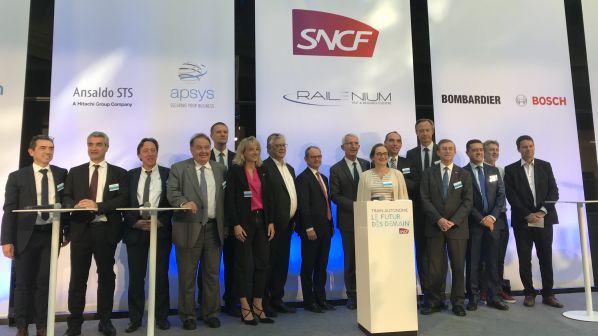Partnering with French state-owned research institute Railenium, SNCF will work with Alstom, Altran, Ansaldo STS and Apsys on the freight project, which will involve equipping an Alstom locomotive for GoA4 operation. The passenger project consortium consists of Bombardier, Bosch, Spirops and Thales and will involve fitting a Bombardier Francilien commuter EMU for GoA4.
The project will cost €57m, with SNCF contributing 30%, Railenium 30%, and the other partners 40%. The agreements were formally announced during a press conference in Paris on September 12.
Work on GoA4 is a key part of a broader SNCF programme to develop autonomous trains for the main line. Mr Pierre Izard, SNCF's chief technology officer, says there are three major milestones for this project. Izard told IRJ that by 2021, a remote control solution will be developed for freight applications and deployed on low-traffic lines in the final 10-30km of journeys at speeds of 30-50km/h.
SNCF has also been working with Alstom to deliver a GoA2 ATO over ETCS application on Paris RER Line E, which is currently used by 1.2 million passengers per day, and this project will be completed by the end of the year.
This will be followed by applications of the prototypes developed by the two consortia for freight at GoA4 and on TER regional services at GoA 3 and 4. Tests on SNCF's infrastructure, deemed the industrialisation stage, will begin in 2021 and conclude in 2023.
Depending on the results of these trials, Izard says SNCF will make a decision on where automation will be deployed, beginning in 2025. The first TGV applications at GoA 2 are also expected in 2023-25, ahead of deployment after 2025.
“The era of the autonomous train will start by 2025,” Izard says. “This is a commitment not only for France but for Europe and other countries which are working on similar projects.”
The idea for each project is to develop a standardised solution that is easily transferrable between different vehicle types rather a bespoke application. For example, the freight application should be adaptable for SNCF’s fleet of maintenance vehicles and shunting locomotives, which account for around 15% of total operation, and according to SNCF president Mr Guillaume Pepy, are a natural application for automation.
Drivers more like pilots
Pepy and other SNCF representatives were keen to talk up the benefits of autonomous operation. For example, they expect automation to increase capacity on the Paris - Lyon high-speed line to 16 trains per hour per direction, compared with a maximum of 12 at present, and enable the maximum speed of RER services to increase from 80km/h to 120km/h. In addition, autonomous operation is expected to reduce energy consumption by 20% and offer a 30% capacity boost, which combined with improved reliability, will open up more paths for freight trains.
They were also keen to downplay the impact of autonomous operation impact on personnel, with Pepy referring to the train driver as “the solution” rather than “the problem” with future train operation.
“We envisage drivers being more like pilots” Pepy said. “They will continue to monitor operation and be ready to step in when the system has problems.”
SNCF is using an open innovation-based approach to develop the programme, with existing rail suppliers and new entrants to the market making up the consortia. Izard says rail will benefit from experience and work underway in other sectors to develop automated transport solutions, and according to Ms Carole Desnost, SNCF's chief innovation officer, this was key to persuading the wide range of suppliers that now make up the consortia to sign up.
With the European Union Agency for Railways currently working on the standard for main line GoA2 applications, which is expected to be finalised in 2021-22, Izard hopes that the work that SNCF is leading will provide a foundation of the development of GoA 3 and 4 standards.
SNCF is also working closely with German Rail (DB) on plans for automation and Pepy says the emphasis here is on speed. He says both partners are keen to avoid the issues which have held up the acceptance of ERTMS as a European standard signalling system.
“We are not going to wait for 20 years to define what the autonomous train is because we are going to be crossing historical boundaries,” Pepy said. “We are convinced that there is a market for autonomous trains so it is more than viable for the industry as a whole to design a standard. Developing standards will introduce economies of scale for the railway, which is extremely important.”

